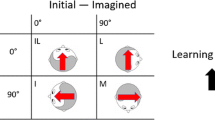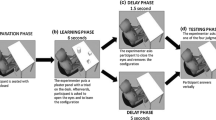Abstract
In this paper, we explore which spatial frames of reference, egocentric or allocentric, are used to locate objects either in relation to ourselves (i.e. subject-to-object localisation) or to other objects (i.e. object-to-object localisation). In particular, we wanted to know whether the same or different frames of reference are used in these two different kinds of localisation after learning the environment in an egocentric way. Egocentric frames of reference are determined by the position of the person in relation to the spatial layout, whereas allocentric frames of reference are centred on the environment or on objects, independent of a person’s position. We hypothesised that subject-to-object localisation is based on egocentric spatial representations, whereas object-to-object localisation is based on allocentric spatial representations. Participants were asked to study eight common objects, placed in a circle. Next, half of the participants had to point to an object in relation to their imagined position (egocentric condition) and the other half to an object in relation to another object (allocentric condition). The overall results show no difference between subject-to-object and object-to-object localisation. In both cases, access to positions corresponding to the front/back body axis was facilitated, in terms of both latency and error. Moreover, participants were able to retrieve objects’ positions better from the perspective from which they had learned the spatial array than from new perspectives. These results support the conclusion that egocentric coordinates, which are selected on the basis of our body-centred experience of the environment, define spatial representations underlying both subject-to-object and object-to-object localisation.





Similar content being viewed by others
References
Acredolo LP (1978) Development of spatial orientation in infancy. Dev Psychol 14:224–234
Acredolo LP (1979) Laboratory versus home: the effect of environment of the nine-month old infant’s choice of spatial reference system. Dev Psychol 15:666–667
Acredolo LP, Evans D (1980) Developmental changes in the effects of landmarks on infant spatial behavior. Dev Psychol 16:312–318
Easton RD, Sholl MJ (1995) Object-array structure, frames of reference, and retrieval of spatial knowledge. J Exp Psychol Learn Mem Cog 21:483–500
Evans GW, Pezdek K (1980) Cognitive mapping: Knowledge of real-world distance and location information. J Exp Psychol Learn Mem Cog 6:13–24
Féry Y-A, Magnac R (2000) Attenuation of alignment effect with exocentric encoding of location. Perception 29:789–799
Franklin N, Tversky B (1990) Searching imagined environments. J Exp Psychol G 119:63–76
Hintzman DL, O’Dell CS, Arndt DR (1981) Orientation in cognitive map. Cog Psychol 13:149–206
Huttenlocher J, Presson CC (1973) Mental rotation and the perspective problem. Cog Psychol 4:277–299
Levine M (1982) You-are-here maps: psychological considerations. Environ Behav 14:221–237
McNamara TP, Rump B, Werner S (2003) Egocentric and geocentric frames of reference in memory of large-scale space. Psychon B R 10(3):589–595
Mou W, McNamara TP (2002) Intrinsic frames of reference in spatial memory. J Exp Psychol 28:162–170
Paillard J (1991) Brain and space. Oxford University Press, Oxford
Pani JR, Dupree D (1994) Spatial reference system in the comprehension of rotational motion. Perception 23:929–946
Presson CC, Hazelrigg MD (1984) Building spatial representations through primary and secondary learning. J Exp Psychol Learn Mem Cog 10:716–722
Presson CC, DeLange N, Hazelrigg MD (1987) Orientation-specificity in kinesthetic spatial learning: the role of multiple orientations. Mem Cog 15:225–229
Presson CC, DeLange N, Hazelrigg MD (1989) Orientation specificity in spatial memory: What makes a path different from a map of the path? J Exp Psychol Learn Mem Cog 15:887–897
Presson CC, Montello DR (1994) Updating after rotational and translational body movements: coordinate structure of perspective space. Perception 23:1447–1455
Richardson AE, Montello DR, Hegarty M (1999) Spatial knowledge acquisition from maps and from navigation in real and virtual environments. Mem Cog 27:741–750
Rieser JJ (1989) Access to knowledge of spatial structure at novel points of observation. J Exp Psychol Learn Mem Cog 15:1157–1165
Roskos-Ewoldsen B, McNamara TP, Carr W, Shelton AL (1998) Mental representations of large and small spatial layouts are orientation dependent. J Exp Psychol Learn Mem Cog 24:215–226
Shelton AL, McNamara TP (1997) Representing space: reference frames and multiple views. In: Shafto MG, Langely G (eds) Proceedings of the 19th Annual Convention of the Cognitive Science Society, Erlbaum, Mahwah, NJ, p 1048
Shelton AL, McNamara TP (2001) System of spatial reference in human memory. Cog Psychol 43:274–310
Sholl MJ, Nolin TL (1997) Orientation specificity in representations of place. J Exp Psychol Learn Mem Cog 23:1494–1507
Taylor HA, Naylor SJ, Chechile NA (1999) Goal-specific influences on the representation of spatial perspective. Mem Cog 27(2):309–319
Thorndyke PW, Hayes-Roth B (1982) Differences in spatial knowledge acquired from maps and navigation. Cog Psychol 14:560–589
Waller D, Montello DR, Richardson AE, Hegarty M (2002) Orientation specificity and spatial updating of memories for layouts. J Exp Psychol Learn Mem Cog 28(6):1051–1063
Author information
Authors and Affiliations
Corresponding author
Rights and permissions
About this article
Cite this article
Nori, R., Iachini, T. & Giusberti, F. Object localisation and frames of reference. Cogn Process 5, 45–53 (2004). https://doi.org/10.1007/s10339-004-0008-0
Received:
Revised:
Accepted:
Published:
Issue Date:
DOI: https://doi.org/10.1007/s10339-004-0008-0




